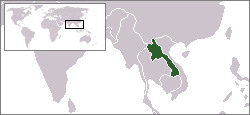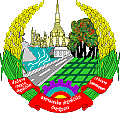Laos
|
|
The Lao People's Democratic Republic is a landlocked country in Southeast Asia, bordered by Myanmar (commonly known in the west as Burma) and the People's Republic of China to the northwest, Vietnam to the east, Cambodia to the south, and Thailand to the west. The term Lao is most frequently used to refer to the dominant language and people of Laos. It is also a romanised form of the word Laos in the Lao language (ລາວ). It is sometimes used in English to refer to the country as well, but romanisation standards hold that "Laos" is the preferred spelling. During its monarchial times before communist rule (pre-1975) the country was called Lan Xang or Land of A Million Elephants.
| ||||
| National motto: Peace, Independence, Democracy, Unity and Prosperity | ||||

| ||||
| Official language | Lao | |||
| Capital | Vientiane | |||
| President | Khamtai Siphandon | |||
| Prime minister | Boungnang Vorachith | |||
| Area - Total - % water | Ranked 79th 236,800 km² 2% | |||
| Population | Ranked 101st
| |||
| Independence
| From France | |||
| Currency | Kip | |||
| Time zone | UTC +7 | |||
| National anthem | Pheng Xat Lao | |||
| Internet TLD | .la | |||
| Calling Code | 856 | |||
| Contents |
History
Main article: History of Laos
The early history of Laos was dominated by the wider Nanzhao kingdom, which was succeeded in the 14th century by the local kingdom of Lan Xang that lasted until its decline in the 18th century, after which Thailand assumed control of the separate principalities that remained. These then came under French influence during the 19th century and were incorporated into French Indochina in 1893. Following a Japanese occupation during World War II, the country became independent in 1949 as the Kingdom of Laos under the leadership of King Sisavang Vong.
Political unrest in neighbouring Vietnam dragged Laos into the greater Second Indochina War (see also Secret War) which was a destabilising factor that contributed to civil war and several coups d'état. In 1975 the communist Pathet Lao backed by the Soviets and communist Vietnamese overthrew the royalist government of King Savang Vatthana who were backed by the US and France. After taking control of the country, they promptly renamed it the Lao People's Democratic Republic. Initial closer ties to Vietnam and socialisation were replaced by a relaxation of economic restrictions in the late 1980s and the admission into ASEAN in 1997.
Politics
Main article: Politics of Laos
The only legal political party is the Lao People's Revolutionary Party (LPRP). The head of state is a president elected by parliament for a five-year term. The head of government is a prime minister appointed by the president with parliamentary approval. Government policies are determined by the party through the all-powerful nine-member Politburo and the 49-member Central Committee. Important government decisions are vetted by the Council of Ministers.
Laos adopted a new constitution in 1991. The following year, elections were held for a new 85-seat National Assembly with members elected by secret ballot to 5-year terms. This unicameral parliament, expanded in 1997 elections to 99 members, approves all new laws, although the executive branch retains authority to issue binding decrees. The most recent elections took place in February 2002 when the assembly was expanded to 109 members.
Provinces
Main article: Provinces of Laos
Laos is divided into 16 provinces (khoueng), 1 municipality* (kampheng nakhon), and 1 special zone** (khetphiset):
- Attapeu
- Bokeo
- Borikhamxay
- Champassack
- Houaphan
- Khammouane
- Louang Namtha
- Louangphabang
- Oudomxay
- Phongsaly
- Saravane
- Savannakhet
- Vientiane *
- Vientiane Province
- Sayaboury
- Saysomboun **
- Xekong
- Xieng Khouang
Geography
La-map.png
Main article: Geography of Laos
Laos is a landlocked country in Southeast Asia and the thickly forested landscape consists mostly of rugged mountains, the highest of which is Phou Bia at 2,817 m, with some plains and plateaus. The Mekong River forms a large part of the western boundary with Thailand, whereas the mountains of the Annamite Chain form most of the eastern border with Vietnam.
The local climate is tropical and characterised by monsoons. There is a distinct rainy season from May to November, followed by a dry season from December to April. The capital and largest city of Laos is Vientiane, other major cities include Luang Phrabang, Savannakhet and Pakse.
In 1993, the government set aside 21% of the nation's land area as National Biodiversity Conservation Areas (NBCA), which may be developed into a national park system. If completed, it is expected to be the most comprehensive and one of the finest national park systems in Southeast Asia.
A number of new animal species have been discovered or re-discovered in Laos in recent years. These include the striped or Annamite rabbit the saola, and most recently the Laotian rock rat or kha-nyou.
Economy
Main article: Economy of Laos
The government of Laos - one of the few remaining official communist states - began decentralising control and encouraging private enterprise in 1986. The results, starting from an extremely low base, were striking - growth averaged 6% in 1988-2004 except during the short-lived drop caused by the Asian financial crisis beginning in 1997. As in many developing countries, the major urban centers have experienced the most growth. The economies of Vientiane, Luang Prabang and Savannakhet, in particular have experienced significant booms in recent years.
Much of the country, however, lacks adequate infrastructure. Laos still has no railroads, although a short link is planned to connect Vientiane with Thailand over the Thai-Lao Friendship Bridge. The major roads connecting the major urban centers, namely Route 13, have been significantly upgraded in recent years, but villages that are far from major roads are accessible only through unpaved roads that may not be accessible year round. There is limited external and internal telecommunications, particularly the wireline sort, but cell phone usage has become widespread in urban centers. Electricity is not available in many rural areas or only during scheduled periods. Subsistence agriculture still accounts for half of GDP and provides 80% of total employment. The economy receives aid from the IMF and other international sources and from new foreign investment in food-processing and mining, most notably of copper and gold.
In late 2004, Laos gained Normal Trade Relations status with the US, allowing Laos-based producers to face lower tariffs on their exports; this may help spur growth.
Demographics
Main article: Demographics of Laos
68% of the country's people are ethnic Lao, the principal lowland inhabitants and the politically and culturally dominant group. The Lao are descended from the Tai people who began migrating southward from China in the first millennium AD. Hill people such as the Hmong (Meo), Yao (Mien), Black Thai, Dao, Shan, and several Tibeto-Burman speaking peoples, have lived in isolated regions of Laos for many years. Mountain tribes of mixed ethnolinguistic heritage are found in northern Laos. Collectively, they are known as Lao Sung or highland Laotians. In the central and southern mountains, Mon-Khmer tribes, known as Lao Theung or midslope Laotians, predominate. Some Vietnamese and Chinese minorities remain, particularly in the towns, but many left in two waves; after independence in the late 1940s and again after 1975.
The term Laotian does not necessarily refer to the ethnic Lao language, ethnic Lao people, language or customs, but is a political term that also includes the non-ethnic Lao groups within Laos and identifies them as "Laotian" because of their political citizenship. In a similar vein the word "Lao" can also describe the people, cuisine, language and culture of the people of Northeast Thailand (Isan) who are ethnic Lao.
The predominant religion is Theravada Buddhism which, along with the common Animism practiced among the mountain tribes, coexists peacefully with spirit worship. There also is a small number of Christians and Muslims. However, religion is strictly controlled, and the government will generally side with Buddhism over a minority religion. In 2004, Open Doors ranked Laos as the fourth worst persecutor of Christians, behind North Korea, Saudi Arabia, and Vietnam.
The official and dominant language is Lao, a tonal language of the Tai linguistic group. Midslope and highland Laotians speak an assortment of tribal languages.
Culture
Main article: Culture of Laos
Theravadan Buddhism has contributed greatly to the Lao culture. It is reflected throughout the country both in its language to the temple as well as art, literature, performing arts, etc. Laotian music is dominated by its national instrument, the khaen (a type of bamboo pipe). Bands typically include a singer/rapper (mor lam) and a khaen player (mor khaen) alongside fiddlers and other musicians. Lam saravane is the most popular genre of Laotian music, but ethnic Lao in Thailand have developed an internationally-best selling form called mor lam sing.
One significant archive of ancient Laotian culture is the Plain of Jars.
See also:
Media
Main article: Media of Laos
All newspapers are published by the government, including two foreign language papers: the English language Vientiane Times and the French language Le Renovateur. Additionally, the Khao San Pathet Lao, the official news agency of the Lao P.D.R., publishes English and French versions of its eponymous paper. Internet cafes, serving the tourist market, are now common in the major urban centers. However, the government strictly censors content and controls access.
Satellite television dishes, beaming content from Thailand, are common throughout Laos. Many Laotians access the outside world through Thai television programs.
Tourist Attractions
- Pak Ou Caves
- Pha That Luang
- The grave of Henri Mouhot
- Sisavang Vong University
- The Plain of Jars
- Luang Prabang
- Vang Vieng
- The Bolovens Plateau
- Wat Phu
Miscellaneous topics
- Communications in Laos
- Transportation in Laos
- Military of Laos
- Foreign relations of Laos
- List of Laos-related topics
- Art of Laos
External links
- Laos' Portal (http://www.laopdr.com) - Directory of Laotian sites
- Mekong Center (http://www.mekongcenter.com/home.htm) - Official tourism site
- Laoconnection.com (http://www.laoconnection.com/) - country, culture, language info., gallery, advice column, and more.
- Wikitravel: Laos (http://wikitravel.org/en/article/Laos)
| Countries in Southeast Asia |
|---|
|
Brunei | Cambodia | East Timor | Indonesia | Laos | Malaysia | Myanmar | Philippines | Singapore | Thailand | Vietnam |
Template:Former French coloniesbg:Лаос ca:Laos da:Laos de:Laos et:Laos es:Laos eo:Laoso fr:Laos ko:라오스 hr:Laos io:Laos id:Laos it:Laos he:לאוס jv:Laos ks:लाओस la:Laonia lv:Laosa lt:Laosas ms:Laos nl:Laos nds:Laos ja:ラオス nb:Laos nn:Laos pl:Laos pt:Laos ru:Лаос sa:लाओस scn:Laos simple:Laos sk:Laos sl:Laos fi:Laos sv:Laos th:ประเทศลาว vi:Lào uk:Лаос zh:老挝


